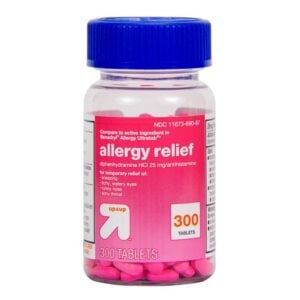Alcohol & Health
Treatment
Helping Alcoholics


In this article
Over 3 million people use BetterHelp. Their services are:
Answer a few questions to get started

Benadryl is the brand name for an antihistamine called diphenhydramine. The drug is a widely used over-the-counter (OTC) medicine for treating allergy symptoms.

During an allergic reaction, your body produces histamine. This natural substance triggers responses like:
Antihistamines, such as diphenhydramine, block your body's response to allergens and reduce allergy symptoms.
Benadryl is a central nervous system (CNS) depressant, just like alcohol. Combining alcohol and Benadryl can increase adverse side effects on your CNS. This heightened risk can produce potentially dangerous consequences.




When Benadryl mixes with alcohol, the combination can be dangerous. Both are central nervous system (CNS) depressants.
Combined, their impact on the central nervous system can lead to intense and heightened side effects. In some cases, this combination can be life-threatening.
The risks associated with combining Benadryl and alcohol may not apply to every person or situation. However, the most responsible practice is abstaining from alcohol while taking diphenhydramine.
If someone has intentionally or unintentionally combined Benadryl with alcohol, it’s essential to ensure that they are in a safe and comfortable space where they can rest, if necessary.
The most common dangers of mixing Benadryl and alcohol include:
Benadryl can lead to sedation and increased sleepiness. This can affect coordination and reaction speed.
Combining Benadryl with alcohol can intensify these side effects. Extreme drowsiness can be life-threatening if engaging in specific activities, like driving or operating large and heavy machinery.
For some, the level of sedation when mixing alcohol and Benadryl is so high that they lose consciousness. Therefore, it’s essential to never mix alcohol and Benadryl before driving, operating machinery, or in any potentially risky situations.
Some people are more prone to losing consciousness than others. This can be harmful due to the increased risk of falls and other accidents.
Aging slows the body’s ability to break down alcohol. That means alcohol may linger in the system of older adults for longer than in younger people.
A dangerous combination of Benadryl and alcohol can be even more intense for seniors. It can lead to issues with their motor skills due to sedation and dizziness. It can also result in an increased risk of falling.
Diphenhydramine blocks the action of a neurotransmitter called acetylcholine. Acetylcholine is crucial for learning and memory. Blocking its action may temporarily affect these processes.
Benadryl may interact with other types of medicines. This can heighten the side effects of the drugs. Taking these different medications with alcohol could also increase the side effects.
Examples of medicines that may interact with allergy medications, like diphenhydramine, include:
Cough syrups and laxatives also contain alcohol. These drugs have up to 10 percent alcohol, which may adversely interact with Benadryl.
As a result, taking Benadryl with medications like cough syrup may increase the risk of harmful side effects, even in small amounts.
Along with drinking alcohol with Benadryl, you must be aware of the alcohol content of other medicines you take.
Generally, women are more susceptible to alcohol-related harm. This is because female bodies usually contain less water for alcohol to mix with. So, the same amount of alcohol can be more concentrated in a woman than in a man.
Because alcohol and Benadryl can cause loss of consciousness, women must take care never to mix the two substances.
Benadryl and alcohol both result in sleepiness and sedation. Unfortunately, many people exploit the combination as a sleeping aid.
This is a dangerous combination. Alcohol and Benadryl can be deadly.
It is possible that combining large amounts of Benadryl and alcohol over extended periods could link to an increased risk of dementia.
One study discovered that individuals who take one anticholinergic drug a day for at least three years have an increased risk of dementia.6 However, it’s essential to note that this study included all anticholinergic drugs, not just Benadryl.
Longitudinal research is still needed to know whether taking Benadryl long-term increases the risk of dementia significantly.2
An excessive combination of Benadryl and alcohol could lead to an overdose. Taking more than the directed dose of Benadryl makes an overdose more likely.
If you overdose on alcohol and Benadryl and lose consciousness, it can lead to death.
Symptoms and side effects of a Benadryl overdose include:
Taking Benadryl with other potent drugs can also increase the risk of overdose. These drugs include:
If you are considering drinking alcohol with Benadryl, speak to your doctor or healthcare provider first. Your doctor can determine whether it’s safe to consume alcohol after taking Benadryl.
They’ll connect you to an addiction and mental health counselor
Find a TherapistAnswer a few questions to get started

Never take Benadryl after drinking. Both Benadryl and alcohol are central nervous system depressants.
Mixing these substances can lead to serious side effects like drowsiness, loss of consciousness, and even an overdose.
In this article

